Một cách tiếp cận mới cho khoảng cách đối ngẫu bằng không của bài toán tối ưu véctơ sử dụng tập đặc trưng
Trong bài viết này, chúng tôi đề xuất các kết quả về khoảng cách đối ngẫu bằng không trong
bài toán tối ưu véctơ trên một không gian vectơ tôpô Hausdorff lồi địa phương với một hàm mục
tiêu có giá trị vectơ được cực tiểu hóa dưới một tập và một ràng buộc nón lồi. Các kết quả này
sau đó được áp dụng cho bài toán quy hoạch tuyến tính.
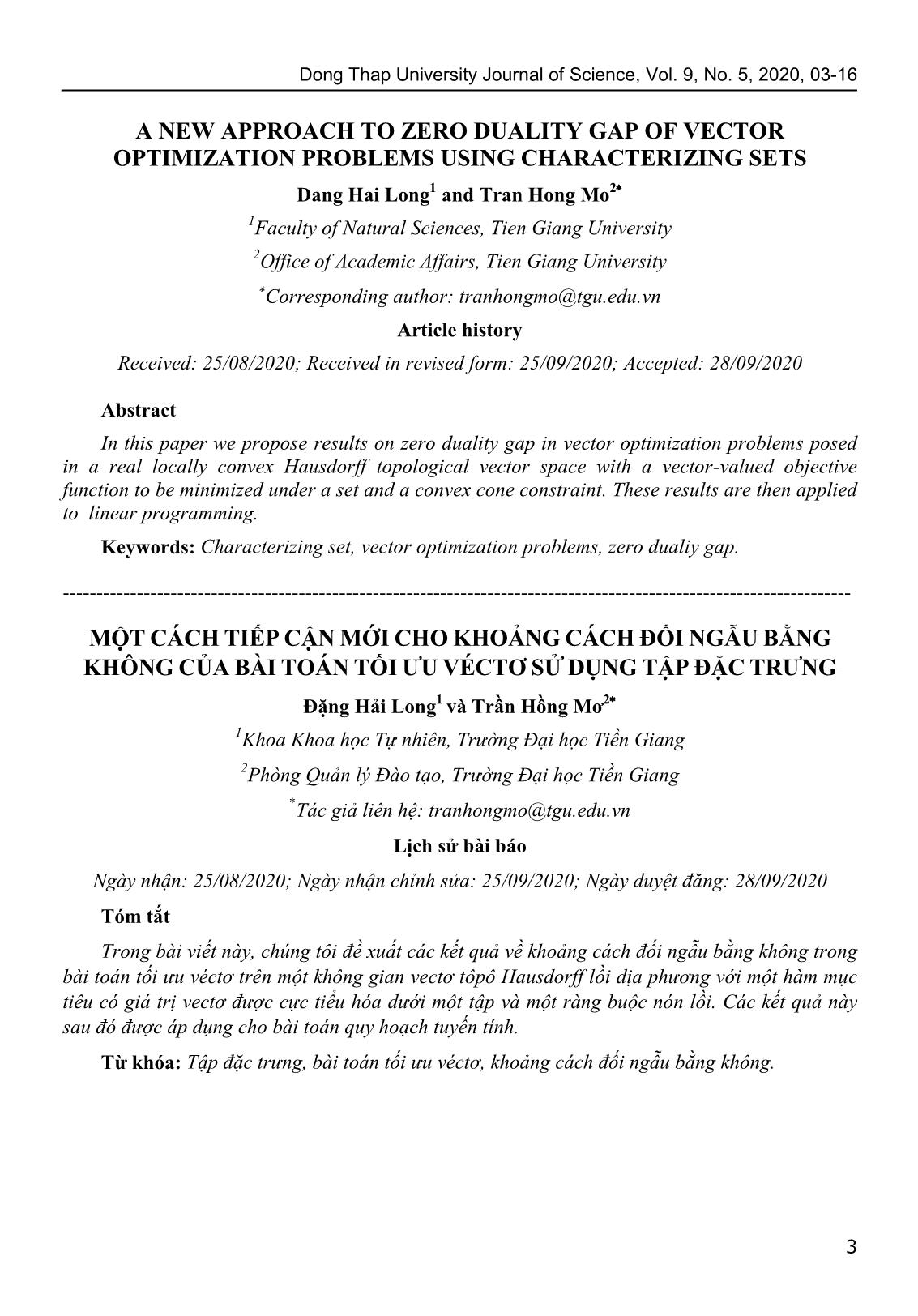
Trang 1
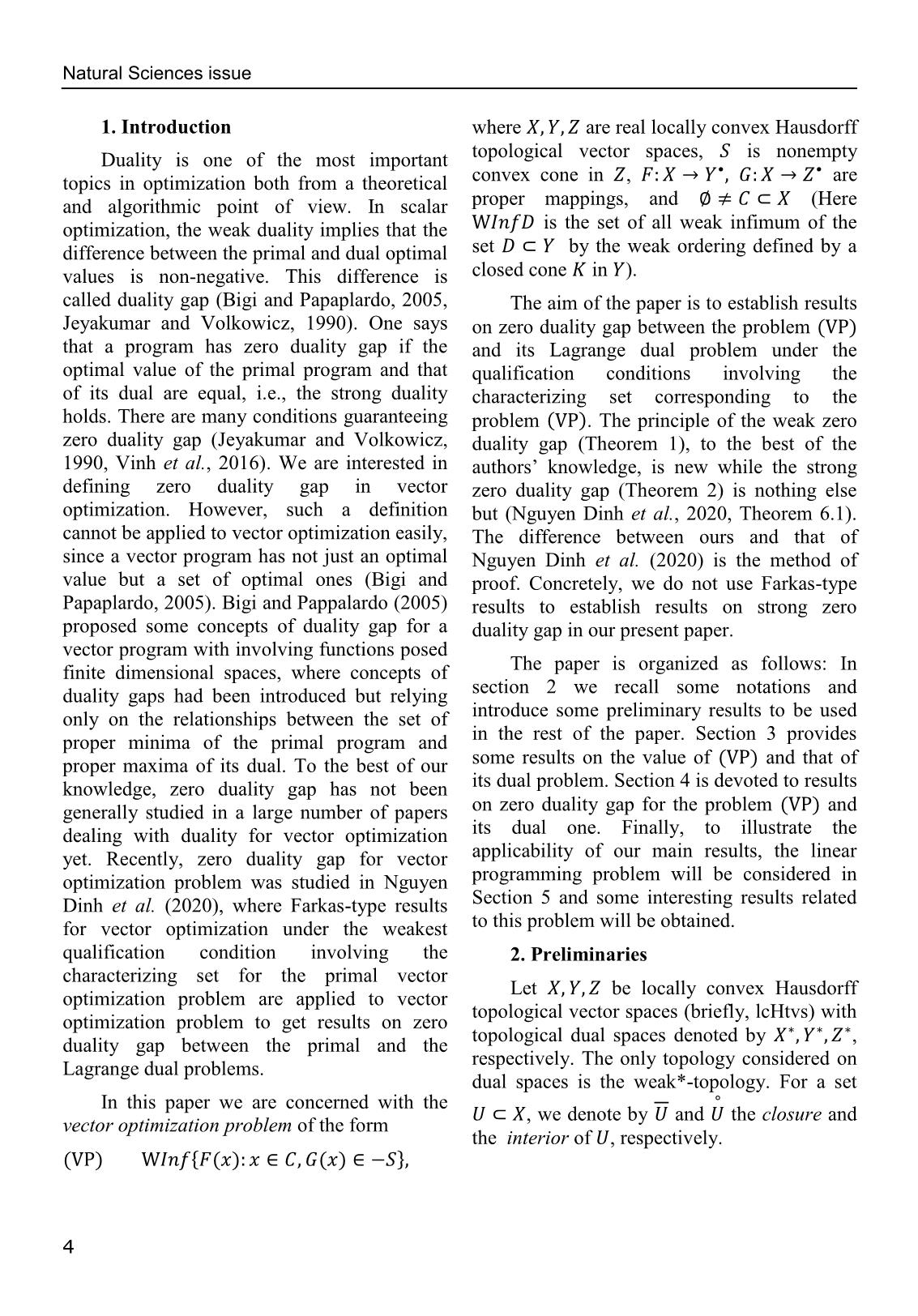
Trang 2
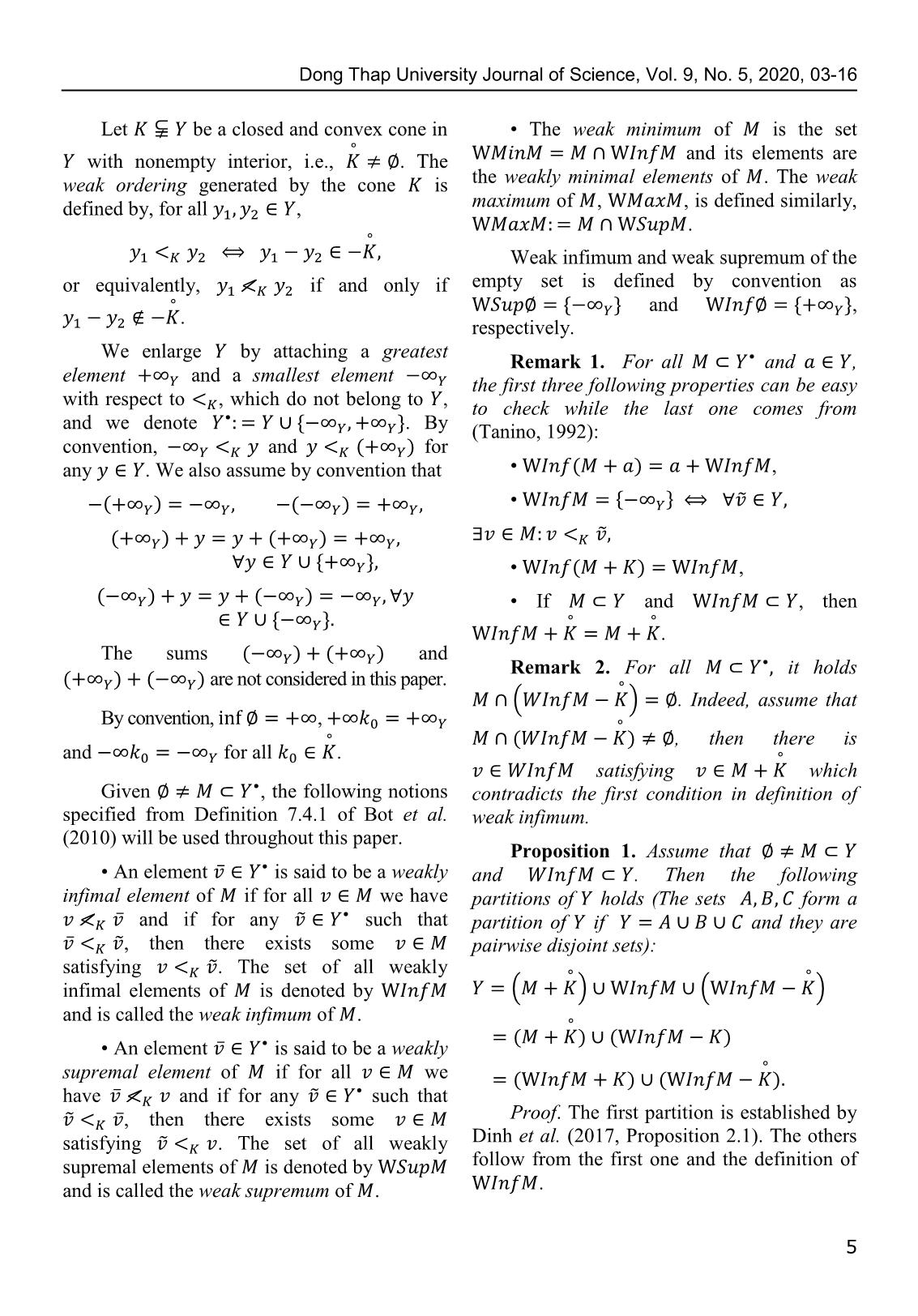
Trang 3
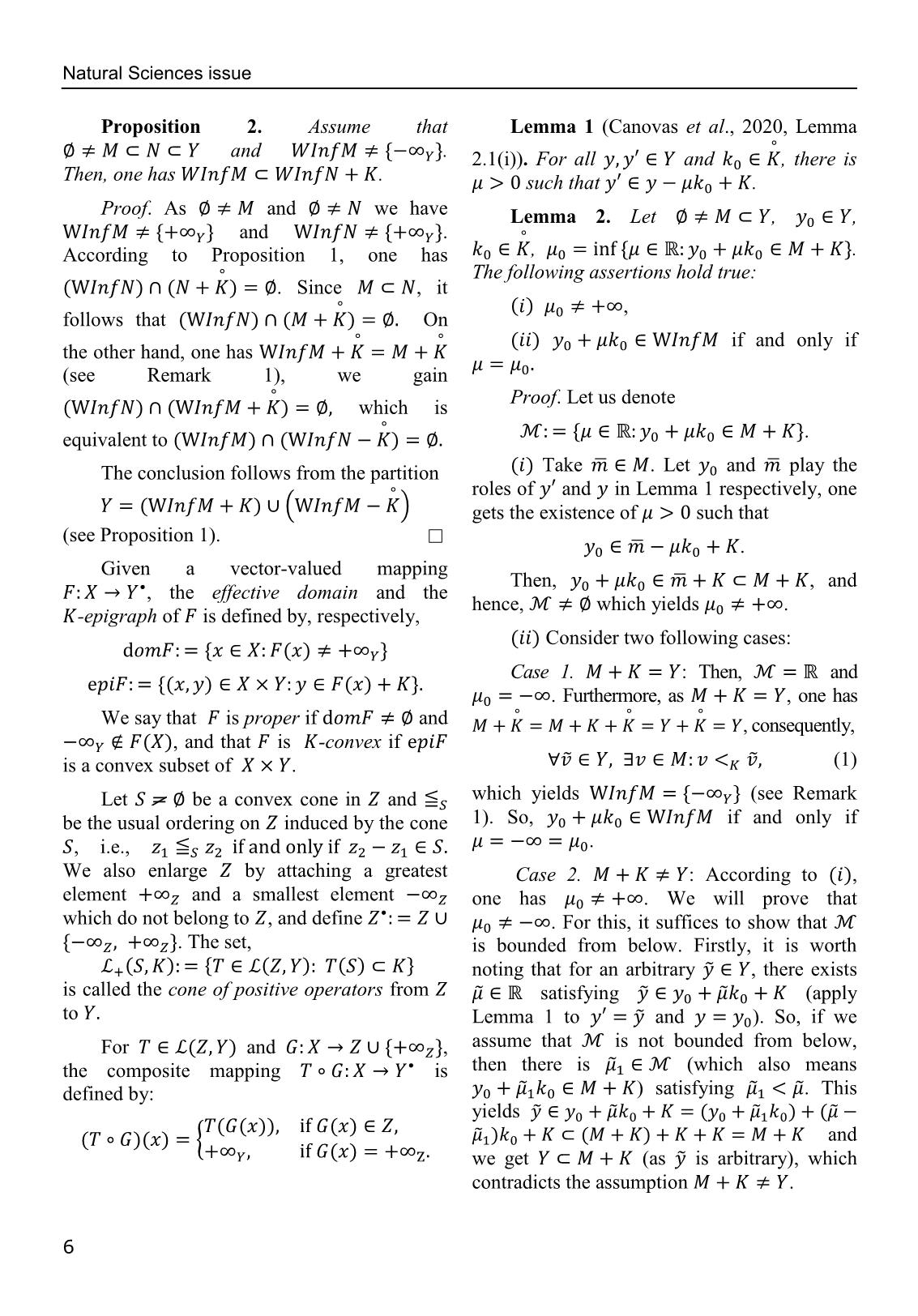
Trang 4
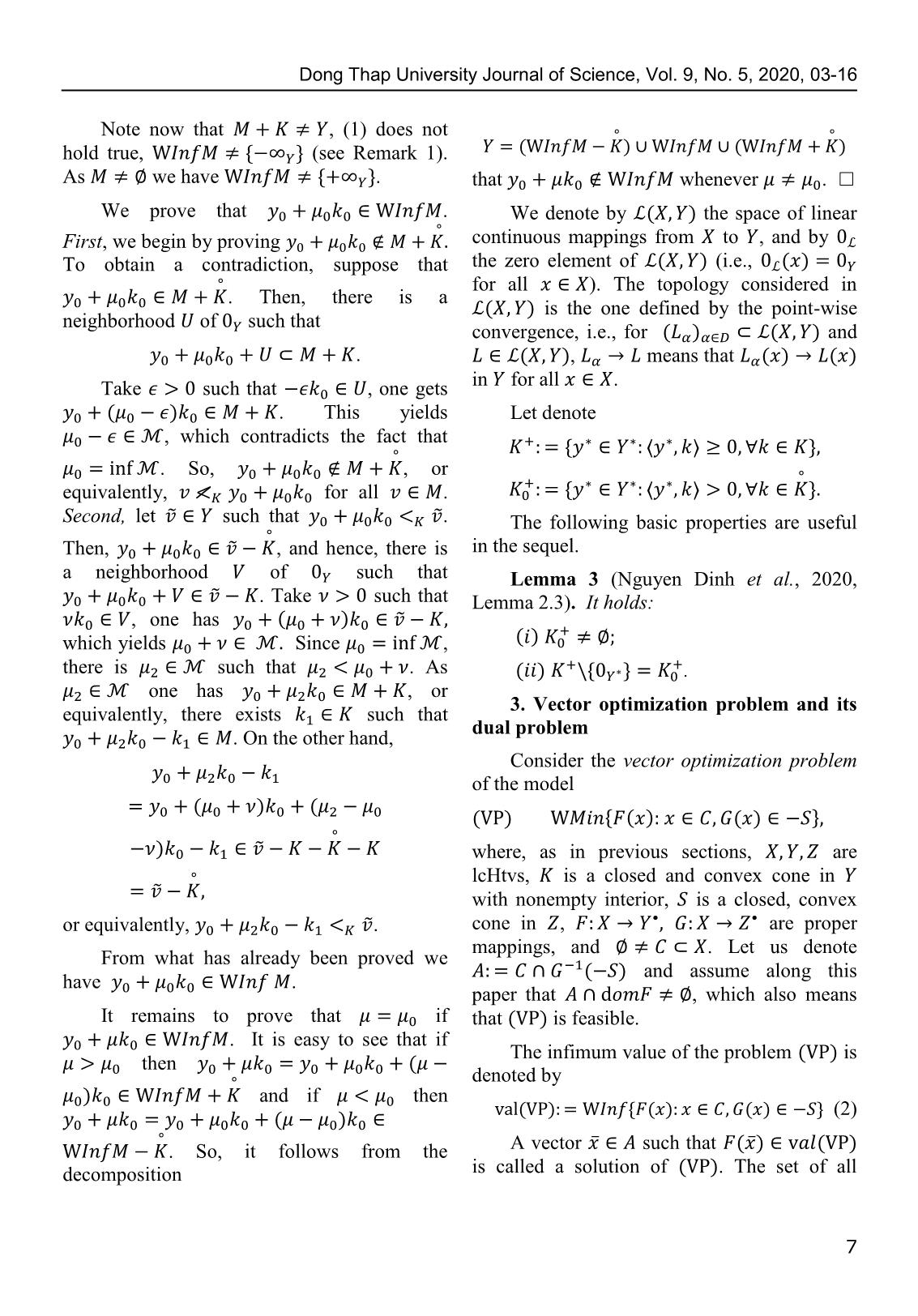
Trang 5
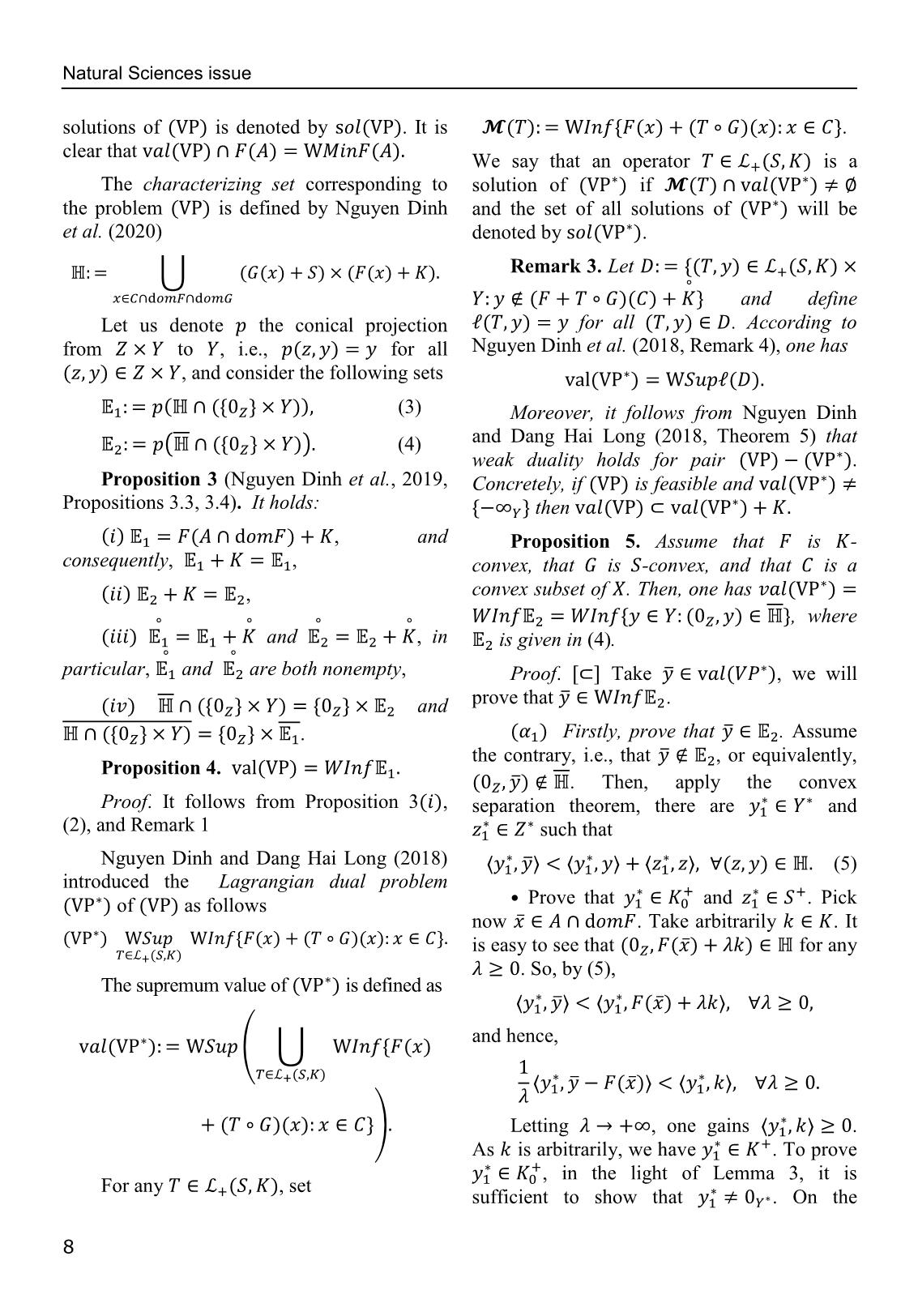
Trang 6
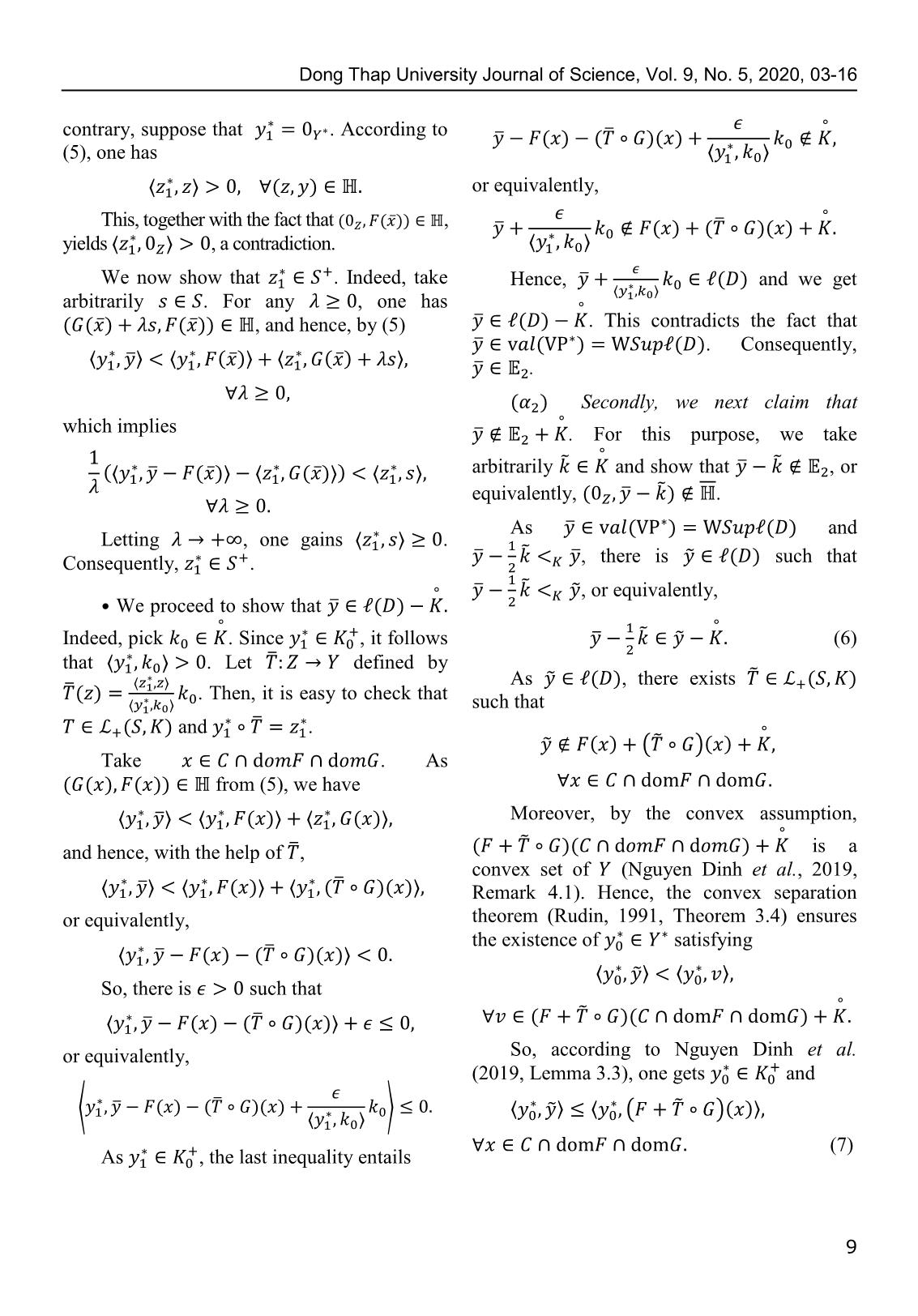
Trang 7
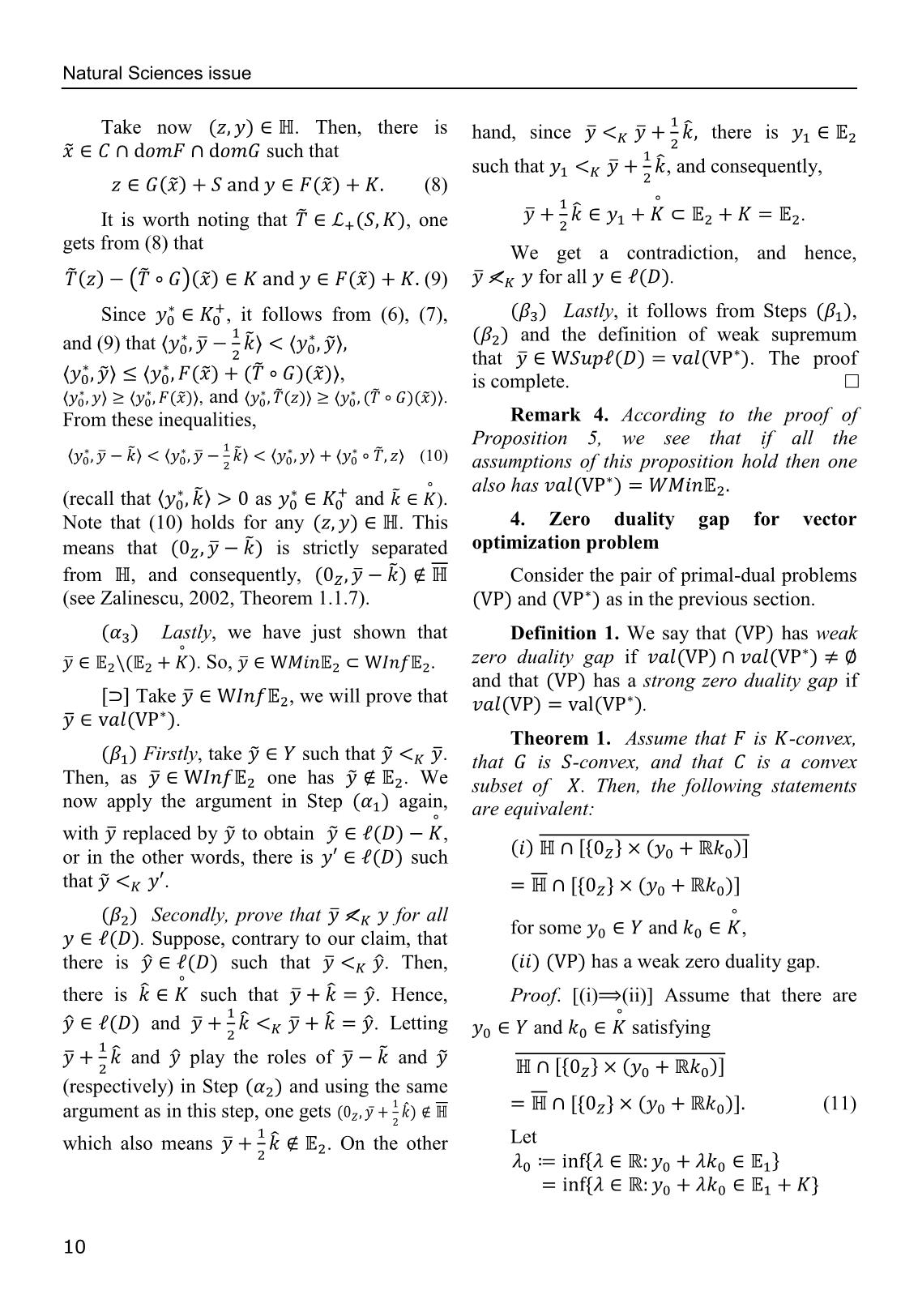
Trang 8
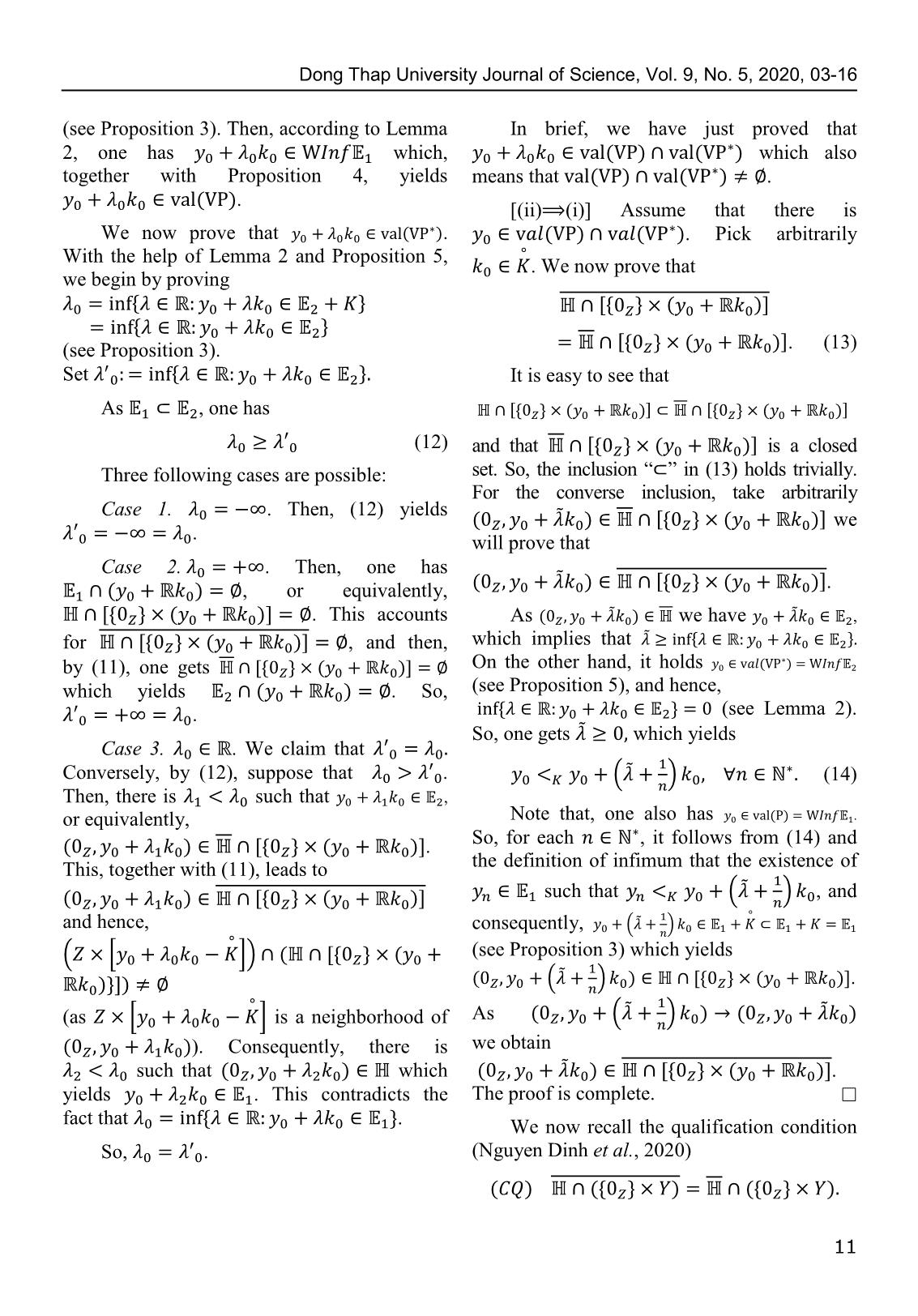
Trang 9
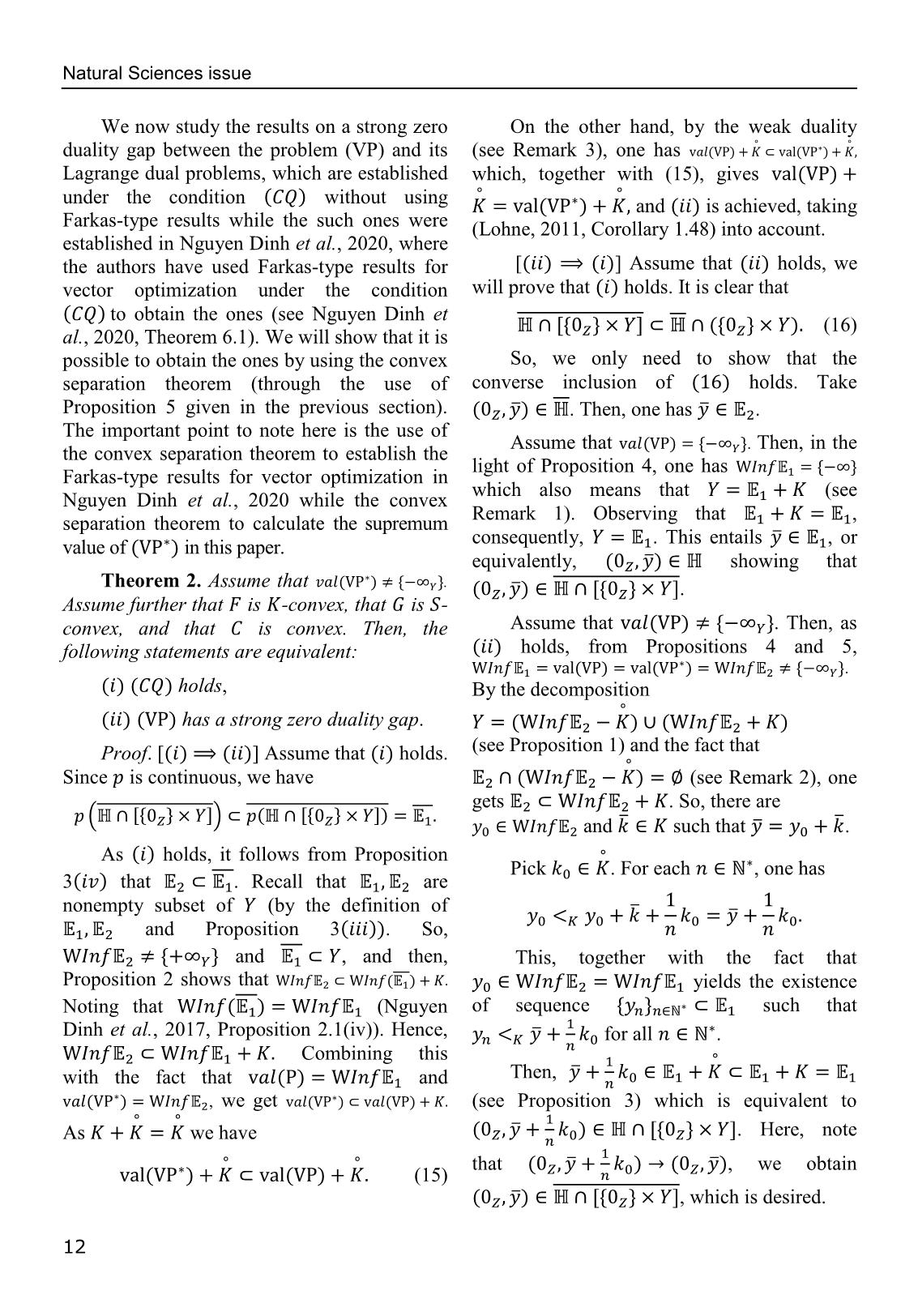
Trang 10
Tải về để xem bản đầy đủ
Bạn đang xem 10 trang mẫu của tài liệu "Một cách tiếp cận mới cho khoảng cách đối ngẫu bằng không của bài toán tối ưu véctơ sử dụng tập đặc trưng", để tải tài liệu gốc về máy hãy click vào nút Download ở trên
Tóm tắt nội dung tài liệu: Một cách tiếp cận mới cho khoảng cách đối ngẫu bằng không của bài toán tối ưu véctơ sử dụng tập đặc trưng
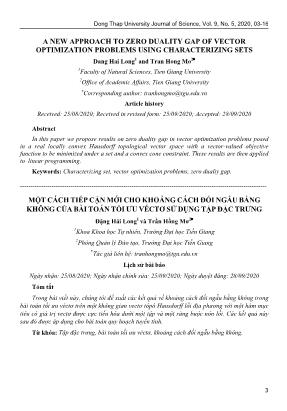
, a contradiction.
We now show that . Indeed, take Hence, ̅ and we get
arbitrarily . For any , one has
̅ ̅ , and hence, by (5) ̅ . This contradicts the fact that
̅ . Consequently,
̅ ̅ ̅
̅ .
Secondly, we next claim that
which implies
̅ . For this purpose, we take
arbitrarily ̃ and show that ̅ ̃ , or
̅ ̅ ̅
equivalently, ̅ ̃ .
As ̅ and
Letting , one gains .
̃
̅ ̅, there is ̃ such that
Consequently, .
̅ ̃ ̃, or equivalently,
We proceed to show that ̅
̃
Indeed, pick . Since , it follows ̅ ̃ (6)
that . Let ̅ defined by
As ̃ , there exists ̃
̅
. Then, it is easy to check that
such that
and ̅ .
̃ ( ̃ )
Take . As
from (5), we have
̅ Moreover, by the convex assumption,
̃
and hence, with the help of ̅, is a
convex set of (Nguyen Dinh et al., 2019,
̅
̅ Remark 4.1). Hence, the convex separation
or equivalently, theorem (Rudin, 1991, Theorem 3.4) ensures
the existence of satisfying
̅ ̅
̃
So, there is such that
̃
̅ ̅
or equivalently, So, according to Nguyen Dinh et al.
(2019, Lemma 3.3), one gets and
̅
⟨ ̅ ⟩ ̃ ( ̃ )
(7)
As , the last inequality entails
9
Natural Sciences issue
Take now . Then, there is ̂
hand, since ̅ ̅ there is
̃ such that
̂
such that ̅ , and consequently,
̃ ̃ (8)
̅ ̂ .
It is worth noting that ̃ , one
gets from (8) that We get a contradiction, and hence,
̃ ( ̃ ) ̃ ̃ (9) ̅ for all .
Since , it follows from (6), (7), Lastly, it follows from Steps ,
and (9) that ̅ ̃ ̃ and the definition of weak supremum
that ̅ . The proof
̃
̃ ̃ ̃ , is complete.
̃ , and ̃ ̃ ̃ .
From these inequalities, Remark 4. According to the proof of
Proposition 5, we see that if all the
̅ ̃ ̅ ̃ ̃ (10)
assumptions of this proposition hold then one
̃ ̃ also has
(recall that as and ).
Note that (10) holds for any . This 4. Zero duality gap for vector
̃ optimization problem
means that ̅ is strictly separated
̃
from , and consequently, ̅ Consider the pair of primal-dual problems
(see Zalinescu, 2002, Theorem 1.1.7). and as in the previous section.
Lastly, we have just shown that Definition 1. We say that has weak
zero duality gap if
̅ . So, ̅ .
and that has a strong zero duality gap if
Take ̅ , we will prove that .
̅ .
Theorem 1. Assume that is -convex,
Firstly, take ̃ such that ̃ ̅. that is -convex, and that is a convex
Then, as ̅ one has ̃ . We subset of . Then, the following statements
now apply the argument in Step again,
are equivalent:
with ̅ replaced by ̃ to obtain ̃ ,
or in the other words, there is such { }
that ̃ . { }
Secondly, prove that ̅ for all
for some and ,
. Suppose, contrary to our claim, that
there is ̂ such that ̅ ̂. Then, has a weak zero duality gap.
there is ̂ such that ̅ ̂ ̂. Hence, Proof. [(i) (ii)] Assume that there are
̂ and ̅ ̂ ̅ ̂ ̂. Letting
and satisfying
̅ ̂ and ̂ play the roles of ̅ ̃ and ̃
{ }
(respectively) in Step and using the same
argument as in this step, one gets ̅ ̂ { } (11)
which also means ̅ ̂ . On the other Let
{ }
{ }
10
Dong Thap University Journal of Science, Vol. 9, No. 5, 2020, 03-16
(see Proposition 3). Then, according to Lemma In brief, we have just proved that
2, one has which, which also
together with Proposition 4, yields means that .
.
[(ii) (i)] Assume that there is
We now prove that . . Pick arbitrarily
With the help of Lemma 2 and Proposition 5,
. We now prove that
we begin by proving
{ } { }
{ }
(see Proposition 3). { } . (13)
Set { } It is easy to see that
As , one has { } { }
(12) and that { } is a closed
Three following cases are possible: set. So, the inclusion “ ” in (13) holds trivially.
For the converse inclusion, take arbitrarily
Case 1. . Then, (12) yields ̃
{ } we
. will prove that
Case 2. . Then, one has
̃
{ } .
, or equivalently,
̃ ̃
{ } . This accounts As we have ,
̃ { }
for { } , and then, which implies that
On the other hand, it holds
by (11), one gets { }
(see Proposition 5), and hence,
which yields . So,
{ } (see Lemma 2).
.
So, one gets ̃ which yields
Case 3. . We claim that
Conversely, by (12), suppose that . ( ̃ ) (14)
Then, there is such that ,
or equivalently, Note that, one also has .
So, for each , it follows from (14) and
{ } .
This, together with (11), leads to the definition of infimum that the existence of
̃
such that ( ) , and
{ }
and hence, consequently, ( ̃ )
(see Proposition 3) which yields
( * +) { }
( ̃ ) { } .
}
As ( ̃ ) ̃
(as * + is a neighborhood of
). Consequently, there is we obtain
̃
such that which { } .
yields . This contradicts the The proof is complete.
fact that { }. We now recall the qualification condition
So, . (Nguyen Dinh et al., 2020)
{ } { }
11
Natural Sciences issue
We now study the results on a strong zero On the other hand, by the weak duality
duality gap between the problem (VP) and its (see Remark 3), one has
Lagrange dual problems, which are established which, together with (15), gives
under the condition without using and is achieved, taking
Farkas-type results while the such ones were (Lohne, 2011, Corollary 1.48) into account.
established in Nguyen Dinh et al., 2020, where
the authors have used Farkas-type results for [ ] Assume that holds, we
vector optimization under the condition will prove that holds. It is clear that
to obtain the ones (see Nguyen Dinh et
{ } { } (16)
al., 2020, Theorem 6.1). We will show that it is
possible to obtain the ones by using the convex So, we only need to show that the
separation theorem (through the use of converse inclusion of holds. Take
Proposition 5 given in the previous section). ̅ . Then, one has ̅ .
The important point to note here is the use of
Assume that { }. Then, in the
the convex separation theorem to establish the
light of Proposition 4, one has { }
Farkas-type results for vector optimization in
which also means that (see
Nguyen Dinh et al., 2020 while the convex
separation theorem to calculate the supremum Remark 1). Observing that ,
consequently, . This entails ̅ , or
value of in this paper.
equivalently, ̅ showing that
Theorem 2. Assume that { }. ̅ { } .
Assume further that is -convex, that is -
convex, and that is convex. Then, the Assume that { }. Then, as
following statements are equivalent: holds, from Propositions 4 and 5,
{ }.
holds, By the decomposition
has a strong zero duality gap.
(see Proposition 1) and the fact that
Proof. [ ] Assume that holds.
Since is continuous, we have (see Remark 2), one
gets . So, there are
( { } ) { } ̅ ̅
and such that ̅ .
As holds, it follows from Proposition
Pick . For each , one has
3 that . Recall that are
nonempty subset of (by the definition of ̅
̅
and Proposition 3 . So,
{ } and , and then, This, together with the fact that
Proposition 2 shows that yields the existence
Noting that (Nguyen of sequence { } such that
Dinh et al., 2017, Proposition 2.1(iv)). Hence, ̅ for all .
Combining this
Then, ̅
with the fact that and
, we get (see Proposition 3) which is equivalent to
̅ { } . Here, note
As we have
that ̅ ̅ , we obtain
(15)
̅ { } , which is desired.
12
Dong Thap University Journal of Science, Vol. 9, No. 5, 2020, 03-16
Remark 5. It is worth mentioning that
when we take , K , ,
{ }
the problem collapses
to the problem in Pham Duy Khanh et al. { }
(2019). Then, the result on strong duality for the { } { }
problem in Pham Duy Khanh et al. { }
(2019, Theorem 4.3) follows from Theorem 2.
{ }, and
Let us now introduce the second
qualification condition, saying that is closed
regarding the set { } concretely,
{ } { } { } { }
Theorem 3. Assume that the problem { }
is feasible and { }. It is clear that the converse implication in
Assume further that is -convex, that is - Theorem 3 does not hold.
convex, and that is a convex set of . If the
5. A special case: Linear programming
condition holds then the problem
has a strong zero duality gap. In the this section, as an illustrate example
for the results established above, we consider a
Proof. According to Proposition 4 and
special case of the problem (VP), that is the
Proposition 5, we have
linear programming:
and . As holds,
one finds that . Consequently, one has
. where , , and .
The following example shows that the Observing that the problem collapses to
converse implication in Theorem 3 does not hold. the problem when we take ,
K , , .
Example 1 Let
Then, the corresponding characterizing set of
and . Let
is
and be such that
and for all . It is easy to { }
see that is -convex, that is -convex, and The qualification condition now is
is convex. In this case, we have
{ } { }
⋃ Recall that the Lagrange dual problem of
denoted by is
⋃
It is worth mentioning that the problem
By some calculations, we obtain is a special case of the linear
programming problem (IP) in Anderson (1983)
{ } { } {
and the problem (ILP) in Pham Duy Khanh et
}
al. (2019) where . The duality for the
{ } { } { problem was considered in Anderson
} (1983) under the closedness conditions.
Recently, Pham Duy Khanh et al. (2019) had
On the other hand,
13
Natural Sciences issue
studied the duality for the problem under (i) holds,
some necessary and sufficient conditions.
(ii)
We now introduce a new type of dual
Proof. Firstly, by Proposition 6, is
problem of called the sequential dual
equivalent to The
problem as follows:
conclusion now follows from Theorem 2.
[ ] We next introduce a sufficient condition,
which ensures the fulfillment of the condition
, and then, leads to the results on zero
The relations between the values of the duality gap for the pairs
problem and its dual problems are given
by the following proposition.
Proposition 7. Assume that there are
Proposition 6. It holds:
and such that
.
(14)
Proof.
(15)
Prove that : It is
easy to see that Then, holds.
{ } Proof. It is sufficient to prove that
{ } { } . To do
{ }
this, take . We will show that
where { } . Indeed, since
{ , it follows that there exists a net
} such that
{ (16)
}
. (17)
Obviously, . So, .
Prove that : Take Assume that there are and
such that (14) and (15) holds. This, together
and such that
with (17), leads to the fact that
Then, for all
, and hence,
for all .
,
Since and , it follows from
or, .
the above inequality that
The desired inequality follows from the
This, together with the last one of (15) and
definition of the problems and .
(14), one gets
The next result extends (Pham Duy Khanh
et al., 2019, Theorem 4.3) in the case when
taking
Corollary 3. The following statements are
equivalent: or equivalently, . From this and the
first one of (15), we obtain
14
Dong Thap University Journal of Science, Vol. 9, No. 5, 2020, 03-16
{ } , References
and hence, { } Anderson, E.J. (1983). A review of duality
as desired. theory for linear programming over
The next result is a direct consequence of topological vector spaces. J. Math. Anal.
Proposition 7 and Corollary 3. Appl., 97(2), 380-392.
Corollary 4. Assume all the assumptions Andreas, L. (2011). Vector optimization with
of Proposition 7 hold. Then, one has infimum and supremum. Berlin: Springer-
Verlag.
Bot, R.I. (2010). Conjugate duality in convex
Corollary 5. Assume that the following optimization. Berlin: Springer.
conditions hold: Bot, R.I., Grad, S.M., and Wanka, G. (2009):
Duality in Vector Optimization. Berlin:
The problem is feasible, i.e.,
Springer-Verlag.
there is such that .
Canovas, M.J., Nguyen Dinh, Dang Hai Long,
. and Parra, J. (2020). A new approach to
strong duality for composite vector
Then, optimization problems. Optimization.
[10.1080/02331934.2020.1745796].
Proof. The fulfillment of means that
there is such that (14). As holds, Elvira, H., Andreas, L., Luis, R., and Tammer,
there exists such that . This C. (2013). Lagrange duality, stability and
leads to the fact that (15) holds. The subdifferentials in vector optimization.
conclusion now follows from Corollary 4. Optimization , 62(3), 415-428.
Jeyakumar, V. and Volkowicz, H. (1990). Zero
Corollary 6. Assume that and one of
duality gap in infinite-dimensional
the following condition holds:
programming. J. Optim. Theory Appl.,
67(1), 88-108.
.
Khan, A., Tammer, C., and Zalinescu, C.
is a surjection.
(2005). Set-valued optimization: An
Then, introduction with applications.
Heidelberg: Springer.
Proof. It is easy to see that if at least one
Nguyen Dinh, Dang Hai Long, Tran Hong Mo,
of the conditions and holds then
and Yao, J.-C. (2020). Approximate
holds as well. So, Corollary 6 is a consequence Farkas lemmas for vector systems with
of Corollary 5. applications to convex vector optimization
Acknowledgements: The work is problems. J. Non. Con. Anal., 21(5),
supported, in part, by the national budget of 1225-1246.
Tien Giang town, under the project “Necessary Nguyen Dinh and Dang Hai Long. (2018).
and sufficient conditions for duality in vector Complete characterizations of robust
optimization and applications ”, Tien Giang, strong duality for robust vector
Vietnam./. optimization problems. Vietnam J. Math.,
46(2), 293-328.
15
Natural Sciences issue
Nguyen Dinh, Goberna, M.A., Lopez, M.A., sufficient conditions for qualitative
and Tran Hong Mo. (2017). Farkas-type properties of infinite dimensional linear
results for vector-valued functions with programming problems. Numer. Func.
applications. J. Optim. Theory Appl., Anal. Opt., 40(8), 924-943.
173(2), 357-390. Rudin, W. (1991). Functional analysis (2nd
Nguyen Dinh, Goberna, M.A., Dang Hai Long, Edition). New York: McGraw-Hill.
and Lopez, M.A. (2019). New Farkas-type Tanino, T. (1992). Conjugate duality in vector
results for vector-valued functions: A non- optimization. J. Math. Anal. Appl., 167(1),
abstract approach. J. Optim. Theory Appl., 84-97.
82(1), 4-29.
Wen, S. (1998). Duality in set-valued
Nguyen Thi Vinh, Kim, D.S., Nguyen Nang optimization. Warszawa: Instytut
Tam, and Nguyen Dong Yen. (2016). Matematyczny Polskiej Akademi Nauk.
Duality gap function in infinite
dimensional linear programming. J. Math. Zalinescu, C. (2002). Convex analysis in
Anal. Appl., 437(1), 1-15. general vector spaces. Singapore: World
Scientificc Publishing.
Pham Duy Khanh, Tran Hong Mo, and Tran
Thi Tu Trinh. (2019). Necessary and
16 File đính kèm:
 mot_cach_tiep_can_moi_cho_khoang_cach_doi_ngau_bang_khong_cu.pdf
mot_cach_tiep_can_moi_cho_khoang_cach_doi_ngau_bang_khong_cu.pdf

